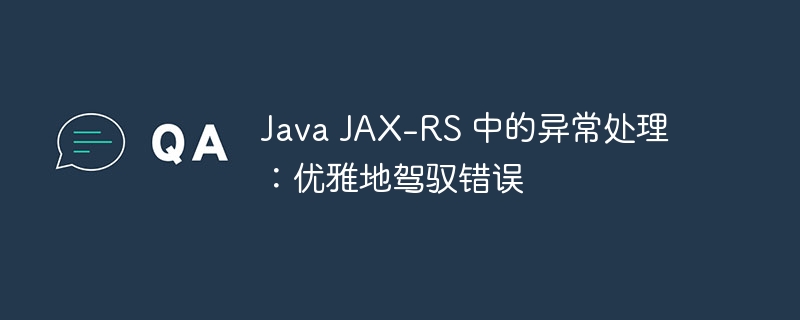

Exception handling in Java JAX-RS has always been the focus of developers. During the development process, how to handle errors gracefully has become an important issue. In this article, PHP editor Yuzai will introduce in detail the best practices for exception handling in Java JAX-RS to help developers better master error handling skills and improve the stability and reliability of the program.
Exception mapper:
Exception mappers are classes in JAX-RS that handle specific types of exceptions. It maps a specific exception class to a Http response code and a response entity. By using exception mappers, developers can provide user-friendly error messages and control the behavior of HTTP responses.
The following is a demo code showing how to use the exception mapper:
@Provider
public class MyExceptionMapper implements ExceptionMapper<MyException> {
@Override
public Response toResponse(MyException exception) {
return Response.status(Response.Status.NOT_FOUND)
.entity("404 Page Not Found")
.type(MediaType.TEXT_html_TYPE)
.build();
}
}HTTP response code:
JAX-RS uses HTTP response codes to indicate the type and severity of the error. Common error response codes include:
400 Bad Request: Indicates a client error, such as invalid request parameters. 401 Unauthorized: Indicates that the client is not authorized. 404 Not Found: Indicates that the requested resource does not exist. 500 Internal Server Error: Indicates that Server encountered an unexpected error. wrong information:
JAX-RS allows developers to provide customized error messages to help users understand errors and take appropriate action. Error messages can be embedded in the exception mapper's response entity.
The following is a demo code showing how to provide a custom error message:
@Provider
public class MyExceptionMapper implements ExceptionMapper<MyException> {
@Override
public Response toResponse(MyException exception) {
return Response.status(Response.Status.NOT_FOUND)
.entity("The requested resource was not found at the specified location.")
.type(MediaType.TEXT_HTML_TYPE)
.build();
}
}Best Practices:
When using JAX-RS exception handling, it is recommended to follow the following best practices:
advantage:
JAX-RS exception handling provides the following advantages:
in conclusion:
The Java JAX-RS exception handling mechanism provides powerful tools to manage and respond to errors in applications. By using exception mappers, HTTP response codes, and custom error messages, developers can provide an elegant user experience while maintaining application robustness. Following the best practices outlined in this article will help create reliable and user-friendly JAX-RS applications.
The above is the detailed content of Exception handling in Java JAX-RS: Managing errors gracefully. For more information, please follow other related articles on the PHP Chinese website!
 Introduction to the meaning of cloud download windows
Introduction to the meaning of cloud download windows
 nvidia geforce 940mx
nvidia geforce 940mx
 What to do if the installation system cannot find the hard disk
What to do if the installation system cannot find the hard disk
 How to modify the text on the picture
How to modify the text on the picture
 seo page description
seo page description
 The difference between PD fast charging and general fast charging
The difference between PD fast charging and general fast charging
 Is Bitcoin trading allowed in China?
Is Bitcoin trading allowed in China?
 pscs5 installation serial number
pscs5 installation serial number




